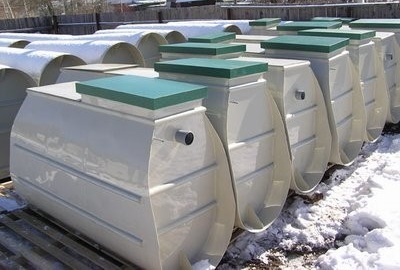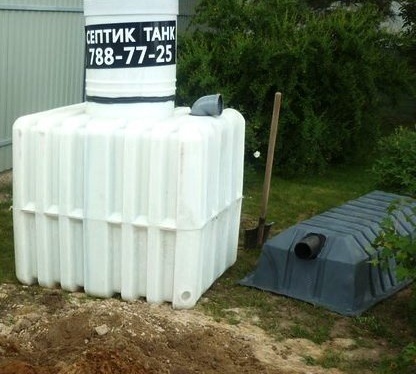How a septic tank works: device diagram and principle of operation of a typical design
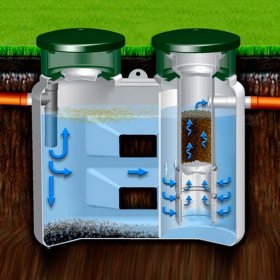
The improvement of a country house or cottage in the absence of nearby centralized sewage networks is carried out using autonomous systems, one of the main elements of which is a septic tank. It is in this tank, consisting of one or several chambers, that wastewater is collected and subsequently treated. The more complicated the septic tank device, the more efficient is the cleaning of the sewage entering it. When choosing the finished design of the treatment plant, the daily amount of waste is taken into account. This value is affected by the number of residents permanently living in the house, as well as the availability and intensity of operation of plumbing equipment. Any type of septic tank should provide a sufficient degree of purification of effluents for their further discharge into the ground without the risk of contamination. If desired, the owner of the house can pump out the septic tank, causing a sewer machine for this purpose.
In the video, as an example, the principle of the septic tank "Poplar" is graphically presented:
How are sewage treated in a septic tank?
Wastewater, falling through a drain sewer into the first chamber of a sewage treatment plant, decomposes into separate fractions. Large solid particles fall to the bottom, and smaller suspensions with water fall into the second chamber, where they are “attacked” by special anaerobic bacteria. In both chambers, fermentation processes are active, as a result of which methane gas is released.
The entrances to the individual compartments of the septic tank are closed by a shutter formed by the flow of water, which prevents the spread of unpleasant odors around the treatment plant. A special removable filter is installed in the third chamber, which traps leaked contaminants from the first two compartments. Here aerobic bacteria enter the struggle for clarification of effluents, the vital activity of which is possible in the presence of oxygen. It is in this way that the principle of the action of septic tanks produced by both Russian and foreign manufacturers can be described.
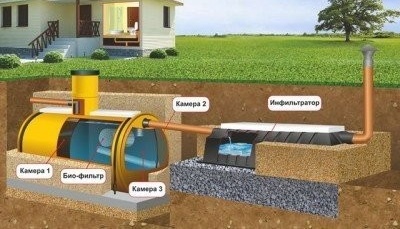
Ready-made septic tanks manufactured by Russian and foreign manufacturers are lowered into the prepared foundation pit. Sewage treated as a result of a three-stage treatment falls into the filtration field and goes into the ground
Important! As a result of multi-stage cleaning of sewage waste, it is effectively cleaned. The treatment plant itself is able to function longer without maintenance and pumping with special equipment. The sanitary condition of the site depends on how the septic tank works. With high-quality cleaning, unpleasant odors with a specific aroma of the existing sewage system never appear near the structure.
The benefits of using septic tanks
Why use this particular treatment plant? And here is why:
- the possibility of the maximum possible cleaning of harmful substances from sewage water;
- operation of structures in any climatic conditions, including at low temperatures in the winter;
- lack of need for frequent pumping;
- long service life of the treatment plant;
- independence of some septic tank models from power supply.
The principles of creating a homemade septic tank
Septic tanks are presented in the Russian market in a large assortment. Ready tanks, oriented in horizontal or vertical position, are easily installed in a pit dug in advance. These containers can be made of durable materials that can withstand the effects of aggressive environments. Typically, manufacturers produce products from plastic and fiberglass, but also there are models made of metal and reinforced concrete structures.
The cost of finished septic tanks is quite high, so many owners of private houses, cottages, summer cottages are engaged in the construction of single-chamber or two-chamber septic tanks with their own hands. At the same time, a trench is dug out manually or with the help of a tractor, into which concrete rings are lowered and connected with an overflow pipe. As a rule, such installation of a treatment plant requires physical effort, but not finance. This is an example diagram of a homemade septic tank constructed of three to six concrete rings.
In the first well (sump), a concrete bottom is necessarily poured, which does not allow dangerous bacteria to enter the soil. In the second well, the bottom base is covered with layers of sand and gravel necessary for filtering effluents that enter the purified form from the sump.
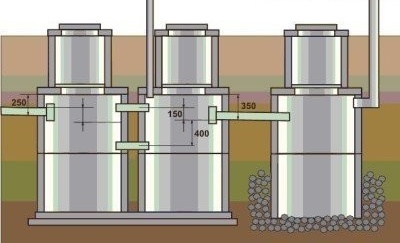
A schematic arrangement of a three-chamber septic tank made of concrete rings in the form of three wells. In the first and second wells, liquid waste is purified, and in the third - their discharge into the ground
Important! To ensure waterproofing the construction of a homemade septic tank, the joints between the rings are coated with cement mortar and additionally treated with special water-repellent mixtures.
Knowing how a typical septic tank is arranged, and by what principle its functioning is organized, you can always build a similar structure with your own hands from available materials.
